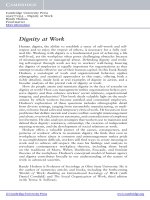Getting organized at work: 24 lessons to set goals, establish priorities and manager your time
Bạn đang xem bản rút gọn của tài liệu. Xem và tải ngay bản đầy đủ của tài liệu tại đây (1.22 MB, 125 trang )
Getting
Organized
at Work
This page intentionally left blank
“I’m amazed at how many time management
courses talk about the ability to change time and
reality. I say rather, ‘Embrace reality and see
what you can do to take advantage of it.’”
This page intentionally left blank
“The key is action. Pick the ideas
and strategies that apply to you.
Then take action and make them work!”
This page intentionally left blank
Getting
Organized
at Work
24 Lessons to Set
Goals, Establish Priorities,
and Manage Your Time
KENNETH ZEIGLER
New York Chicago San Francisco Lisbon
London Madrid Mexico City Milan New Delhi
San Juan Seoul Singapore Sydney Toronto
ឡ
Copyright © 2008 by McGraw-Hill, Inc. All rights reserved. Manufactured in the United
States of America. Except as permitted under the United States Copyright Act of 1976, no
part of this publication may be reproduced or distributed in any form or by any means, or
stored in a database or retrieval system, without the prior written permission of the
publisher.
0-07-159139-7
The material in this eBook also appears in the print version of this title: 0-07-159138-9.
All trademarks are trademarks of their respective owners. Rather than put a trademark sym-
bol after every occurrence of a trademarked name, we use names in an editorial fashion only,
and to the benefit of the trademark owner, with no intention of infringement of the trademark.
Where such designations appear in this book, they have been printed with initial caps.
McGraw-Hill eBooks are available at special quantity discounts to use as premiums and sales
promotions, or for use in corporate training programs. For more information, please contact
George Hoare, Special Sales, at or (212) 904-4069.
TERMS OF USE
This is a copyrighted work and The McGraw-Hill Companies, Inc. (“McGraw-Hill”) and its
licensors reserve all rights in and to the work. Use of this work is subject to these terms.
Except as permitted under the Copyright Act of 1976 and the right to store and retrieve one
copy of the work, you may not decompile, disassemble, reverse engineer, reproduce, modify,
create derivative works based upon, transmit, distribute, disseminate, sell, publish or
sublicense the work or any part of it without McGraw-Hill’s prior consent. You may use the
work for your own noncommercial and personal use; any other use of the work is strictly pro-
hibited. Your right to use the work may be terminated if you fail to comply with these terms.
THE WORK IS PROVIDED “AS IS.” McGRAW-HILL AND ITS LICENSORS MAKE NO
GUARANTEES OR WARRANTIES AS TO THE ACCURACY, ADEQUACY OR COM-
PLETENESS OF OR RESULTS TO BE OBTAINED FROM USING THE WORK,
INCLUDING ANY INFORMATION THAT CAN BE ACCESSED THROUGH THE WORK
VIA HYPERLINK OR OTHERWISE, AND EXPRESSLY DISCLAIM ANY WARRANTY,
EXPRESS OR IMPLIED, INCLUDING BUT NOT LIMITED TO IMPLIED WAR-
RANTIES OF MERCHANTABILITY OR FITNESS FOR A PARTICULAR PURPOSE.
McGraw-Hill and its licensors do not warrant or guarantee that the functions contained in the
work will meet your requirements or that its operation will be uninterrupted or error free.
Neither McGraw-Hill nor its licensors shall be liable to you or anyone else for any inaccura-
cy, error or omission, regardless of cause, in the work or for any damages resulting therefrom.
McGraw-Hill has no responsibility for the content of any information accessed through the
work. Under no circumstances shall McGraw-Hill and/or its licensors be liable for any
indirect, incidental, special, punitive, consequential or similar damages that result from the
use of or inability to use the work, even if any of them has been advised of the possibility of
such damages. This limitation of liability shall apply to any claim or cause whatsoever
whether such claim or cause arises in contract, tort or otherwise.
DOI: 10.1036/0071591389
We hope you enjoy this
McGraw-Hill eBook! If
you’d like more information about this book,
its author, or related books and websites,
please click here.
Professional
Want to learn more?
ix
Organize for success! 1
Let events rule
Take control of your day 5
Do everything yourself
Train others 9
Postpone starting
Get projects done 13
Just be optimistic
Think realistically 17
Start now
Plan your work 21
Put it off
Don’t procrastinate 25
Go with the flow
Organize your work 29
Contents
For more information about this title, click here
x
Don’t look ahead
Add closure daily 33
Do what’s easiest first
Use the “veggie principle” daily 37
Make a to-do list
Plan for power 41
Follow your feelings
Prioritize requests 45
Don’t sweat the details
Give specific directions 49
Work longer hours
Find more time for you 53
Work now, organize later
Control your desk 57
Organize occasionally
Manage your desk 61
Be available always
Limit interruptions 65
Let your e-mail manage you
Manage your e-mail 69
Type and send, then think
Master outgoing e-mail 73
Let your phone manage you
Manage incoming calls 77
Call and talk, then plan
Master outgoing calls 81
Do it all yourself
Delegate 85
Meet: it’s good for business
Plan meetings smartly 89
Gather and go
Run smart meetings 93
Just let the meeting ramble
Close and execute 97
The McGraw-Hill Mighty
Managers Handbooks
105
xi
This page intentionally left blank
Getting
Organized
at Work
This page intentionally left blank
1
፬
Organize for
success!
ឡ
The goal of this book is to provide tips, tools, ideas,
and strategies that you can apply and see immedi-
ate, measurable improvement, both at work and at
home. This book will help you use whatever system
you’re currently using more effectively.
Many time management courses talk about the
ability to change time and reality. That seems
impractical. Instead of acting like the salmon and
swimming against the current, go with the flow—
but add structure and discipline.
This book is intended to get you to analyze your
use of time and answer this question: Why are you
doing what you’re doing when you’re doing it?
Follow these three steps:
1. Keep track of your time (work and personal) for
a week. It may surprise you to find out how
much time tasks and activities take.
Copyright © 2008 by McGraw-Hill, Inc. Click here for terms of use.
2
2. Then, analyze your findings. Identify any activi-
ties that are unnecessary and eliminate them.
3. Find or create times that you could block off for
important tasks or activities that have a high pay-
off. Sometimes these tasks and activities get
delayed because of things that are relatively less
important or even unnecessary.
Once you keep track of your time for a week,
you should see patterns in activities, tasks, interrup-
tions, and unplanned events. Once you see those
patterns, use the strategies discussed in this book to
handle them more effectively.
The key is action. Pick two or three ideas or
strategies at a time and work on them until they
become a habit. Then pick two or three more and
work on them until they become a habit. At the end
of every week, ask yourself what you could do bet-
ter next week. In addition, realize that there are two
aspects to saving time:
■
Improving your time management skills
■
Training others so their time management skills
don’t interfere with yours.
“This book is for anyone who would like to
become more efficient, get more done in less time,
and have balance in life.”
This page intentionally left blank
takes control of you? You must become more
“proactive” and less “reactive” to become the
“Ringmaster” instead of the beast. The Ringmaster is
very patient and consistent, and has discipline. Here
are seven strategies to take control of your day:
Slow down: You’re moving so fast that it takes
multiple phone calls, e-mails, and meetings to
accomplish the same thing we used to be able to do
more simply. The Ringmaster tries to send an e-mail
only once, make this call once, and/or have this
meeting once. In order to do this, you would have
to plan your call before you pick up the phone, plan
your e-mail before you start typing, and prepare and
give out an agenda well in advance of your meeting.
5
፬
Let events rule
፬
Take control of
your day
ឡ
Copyright © 2008 by McGraw-Hill, Inc. Click here for terms of use.
6
Stop doing everything immediately: The single
most counterproductive event you experience daily
is doing everything the second someone asks or you
think of it. Start negotiating new requests so they fit
better into your day, but still work for the requestor.
This will improve the number of tasks you are com-
pleting daily.
Cut down on relationship building: When you get
into a groove first thing in the morning and a cowork-
er stops by to chat, the Ringmaster suggests talking at
break time or at lunch, when it’s most appropriate.
The Ringmaster realized that relationship build-
ing was all about quality, not quantity. If you set
aside time each day to share with and listen to oth-
ers, the quality of your working relationships would
actually improve.
Batch like tasks or activities: The Ringmaster sets
up times each day to work on like activities he or
she has to accomplish to have more DISCIPLINE.
The Ringmaster tries to answer e-mail, say, four
times a day and turns off the audible notification. By
only answering e-mails, each e-mail will take less
time because you are basically replicating the same
activity over and over. Now return phone calls.
Finally go see your direct reports and see if they
need any help or answers to questions.
Direct the request to the right person: Are you a
people pleaser? When the Ringmaster gets a request
that is not in his or her area of expertise, he or she
directs the requestor to the right person. It is faster
for the right person to answer the question or solve
the problem than it is for you to try to do it! Focus on
making sure you get your required work out of the
way; otherwise, it will be left until the end of the day.
Improve the way you communicate: One of the
fastest ways to improve productivity is to be more
specific and detailed with others. This will save time
for you, your direct reports, and others. This really
eliminates questions and misunderstandings. Stop
using “ASAP” immediately! You must improve the
way you communicate first. Could you eliminate
simple questions by being more specific?
Do one thing at a time, like successful people do:
Try to bring 100 percent of your focus and concen-
tration to bear on one activity. Tasks will take less
time to complete and you’ll make fewer mistakes.
Either choose the phone call or the e-mail message,
and put off the other until you’ve finished the one
you chose. It’s not about how many tasks you start
in a day, it’s about how many you complete.
“To become a ringmaster, you must realize that
there’s a time and a place for everything.
Successful time managers realize that it’s all
about discipline.”
7
ability to train others, including your peers and direct
reports. Training is such a difficult skill because it
takes time and effort to be truly successful.
The Ringmaster realized a long time ago that
even if he or she had excellent time management
skills, his or her coworkers and direct reports would
still make life difficult with their poor time manage-
ment skills. Here are four suggestions:
Problem solving and questions: When direct
reports or peers come to you with a problem or
question, you should realize it is a training oppor-
tunity in disguise. (If you answer their questions or
solve their problems quickly, they will be back again,
usually asking roughly the same questions.) Ask
them to:
■
Clearly identify their problem or question
■
Explain what they have already tried
9
፬
Do everything yourself
፬
Train others
ឡ
Copyright © 2008 by McGraw-Hill, Inc. Click here for terms of use.









